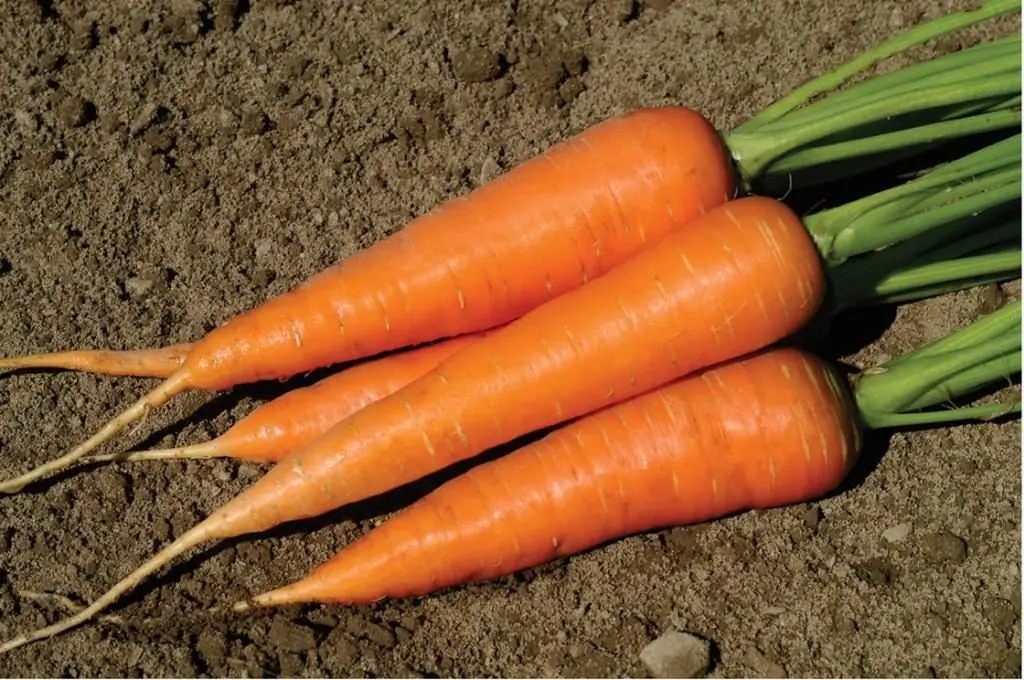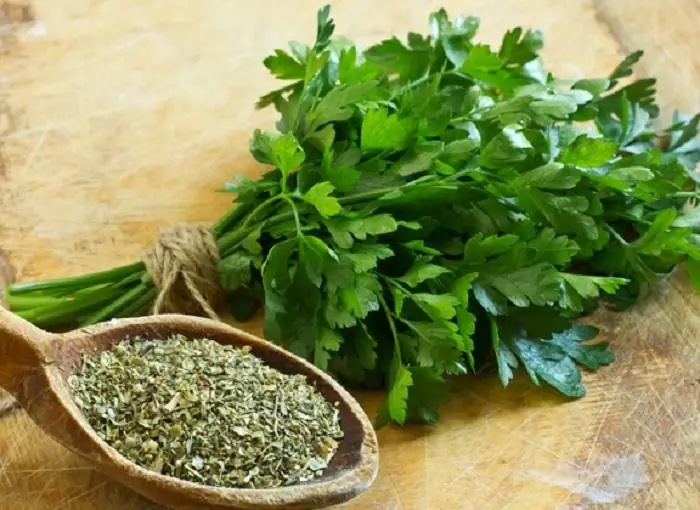2026 Author: Isabella Gilson | [email protected]. Last modified: 2025-01-23 12:50:30
Parsley is an inconspicuous but irreplaceable "inhabitant" of any garden. Vegetable growers willingly grow spices in their summer cottages. And there are reasons for this. What is the secret of parsley's popularity? The chemical composition and nutritional value of this plant give an excellent idea of its wonderful properties.
What is this

Parsley (Petrocelinum) is a biennial plant from the Apiaceae family. It grows up to 100 cm in height. Its stem is straight and branched. The root has a thickened shape. The leaves of the plant are triangular, shiny, dark green in color with a slight glossy sheen on the upper side. The flowers are small, greenish-yellow. Oblong-shaped fruits appear in August. The culture grows in a wild or cultivated form. Currently, there are many varieties of this plant. The most popular variety is curly parsley (Petrocelinum crispum).
A bit of history
The plant has been known since ancient times. his homelandconsidered to be the coast of the Mediterranean Sea. However, early references to parsley still exist in ancient Egyptian texts. The legend says that the plant grew on the place where the competition between the gods: Horus and Set took place, and was sprinkled with blood. The ancient Romans brought parsley to Europe, who used the leaves of the plant to treat various diseases. In cooking, parsley (the chemical composition is discussed below) began to be used later.
In Russia, culture began to grow at the beginning of the 19th century. The vegetable plant was called "bride" or "petrosilia". Many folk superstitions, ceremonies and rituals are associated with parsley. The plant has been cultivated since the 20th century everywhere. Spice spread in Europe, North America, China. The culture tolerates frost well and prefers moist soil.
Nutritional value
Parsley is the leader in vitamin content among vegetable crops. The plant contains vitamins of groups B, K, PP, beta-carotene. Only 100 g of spicy herb can provide a person with a daily dose of ascorbic acid. Vegetables contain more of it than citrus fruits. Parsley is a green, the chemical composition of which is represented by active macronutrients. The culture is rich in calcium, magnesium, iron, phosphorus. Flavonoids, important fatty oils, glycosides, and starch were found in the composition of the spice. Parsley contains proteins, fats, carbohydrates. The calorie content of the main vegetable crops for comparison is presented in the table.

All parts of the plant have a spicy flavor thatdue to the presence of essential oils. It is most often a greenish liquid. The root of the plant contains about 7% of essential oils, perhaps the most important of which is apiol. The chemical composition of the culture includes stearic and palmitic acid, adelhydes, pectins, ketones, phenols.
Fresh parsley has only 36 calories per 100 grams. And the value of the product for the body is huge. For comparison, take dill and parsley. The calorie content of dill per 100 grams is 50 calories. People have been using this spicy plant for more than the first millennium, and in Europe they learned about it after the 16th century. The chemical composition of greens in the context of BJU (share /% of the daily norm):
- proteins - 3.7 g (4.51%);
- fats - 0.4g (0.62%);
- carbs - 7.6 g (5.94%).
Calorie content per 100 grams of parsley compared to other herbs: cilantro (24 cal.), celery (15 cal.), basil (22 cal.) is significantly higher.
Secrets of popularity
Parsley is a spice with an ancient history, loved by many people. The plant has many advantages compared to other vegetable crops. This is an indispensable component that is intensively used in cosmetology and medicine. Many remedies and preparations are based on parsley. The chemical composition of this vegetable plant is characterized by a we alth of proteins and sugars (glucose, fructose, sucrose, as well as xylose in root crops).
Vegetable plant is part of many traditional dishes from different cuisines of the world. It is no coincidence that she fell in love with manyvegetable growers. The culture is widespread, unpretentious to growing conditions. The vegetable plant is often found in the wild. Cultivation does not have a big effect on the taste. But this is not the most important thing. Parsley is a rich "pantry" of vitamins and macronutrients important for humans. The calorie content of fresh parsley per 100 grams is almost equal to the nutritional value of citrus fruits.
What is the use of

Vegetable plant has many wonderful features that are used in different areas of human life. The product is always at hand. It is easy to find and use at home. People of all ages love this simple spice for its unique properties. Regular use of parsley helps to strengthen vision, improve the condition of hair and skin, and whiten teeth. Parsley is able to heal the gums, get rid of inflammatory diseases.
The therapeutic effect of the plant on humans has been known for a long time. The spice has been used for a long time and effectively to treat itching after insect bites, increase potency, and regulate the menstrual cycle. There are many folk recipes based on parsley that have been passed down from generation to generation. Drugs, which include spice, increase immunity, have vasodilating properties.
Experts advise including parsley in the diet for any diet. It will help lower blood sugar, stabilize the digestive processes in the body. Cause the unique properties of parsley, the chemical composition andthe nutritional value. Eating it regularly will improve your mood and keep you alert.
Contraindications
Parsley is a delicious and fragrant spice that is popular as a seasoning among all segments of the population. People of all ages prefer this modest vegetable plant. Experts recommend including spices in your daily diet more often. Despite everything, there are some contraindications that must be considered.
Experts advise pregnant women not to use parsley. The spice can cause kidney irritation and stimulate miscarriage. You should refrain from using a vegetable plant for certain diseases: cystitis, anemia, inflammation of the bladder, high blood pressure. This is due to the fact that the product has a diuretic effect.
There are no restrictions for the regular use of a vegetable plant. However, everything is good in moderation. Abuse of the product can cause poisoning, nausea, headaches, indigestion, convulsions.
How to choose

You can be completely sure of the quality of the product only if the parsley was grown on your own. When buying spices, experts advise paying attention to some nuances. The purchase of a low-quality product can cause serious harm to human he alth. There are a few simple tips to keep in mind when going to a store or market:
- Greens should be fresh in appearance, notfaded.
- The color of plants should be uniform and saturated.
- Sprigs of parsley should be neat and clean.
- Leaves should be free of signs of fungal and bacterial diseases.
- The package of parsley must not be damaged.
Application

Parsley is used in cooking, cosmetology, and medicine. For this purpose, all parts of the plant are used: tender shoots of the first year of cultivation, strong roots, juicy stems. Parsley is an ingredient in many herbs. The leaves and roots of the spice are used to flavor and decorate various traditional dishes. It is added to various marinades, sauces, salads. A vegetable plant is consumed fresh, dried, frozen. The taste of the spice after heat treatment only intensifies and persists for a long time.
Spice is a success in cosmetology. It is part of many sprays, whitening masks, anti-aging creams. The plant is often used at home for the preparation of various decoctions, tinctures. Especially popular is parsley oil, which improves complexion and relieves swelling.

Parsley is an important source of vitamins and macronutrients. The use of spices in medicine is extensive. The plant is used for the production of drugs intended to stabilize metabolism, improve digestion, strengthen blood vessels, normalize blood pressure, treat anti-inflammatory diseases, regulate thyroid function.gland.
Seed preparations are used to treat malaria. A persistent diuretic effect and low calorie content make it possible to effectively use parsley in dietology. The chemical composition and nutritional value distinguishes it from other vegetable crops.
Note to scholars

Finally, some interesting facts about the plant:
- In ancient Greece, parsley was called a plant growing on a stone, because of its unpretentiousness.
- Maria de Medici used the spice to combat fatigue and improve her mood.
- In ancient Rome, the winners of the competitions were given garlands with parsley.
- In ancient China, tea was brewed with fragrant parsley.
- Vegetables used to be necessarily grown on warships in order to diversify the diet of the crew.
- In the Middle Ages, parsley was often planted near churches. The plant acquired great importance during religious sacraments and rituals.
- In Russia, ordinary people called the spice "bride-in-law". The plant was often used by brides before the wedding in order to lose weight, improve complexion, and give the skin a he althy glow and blush.
Recommended:
Carrots: description of varieties, useful properties, chemical composition and calorie content

Carrot is a root crop that has a rich composition, which is the reason for its beneficial properties. Individual varieties of carrots may differ in size, color and taste characteristics. Before sowing a root crop, it is worth studying what types of it are
Parsley: calorie content of the product and useful properties

Characteristic of the plant. The use of parsley in cooking and medicine. Calorie content of parsley and its beneficial properties
What is useful champignon: composition, nutritional value, useful properties, calorie content, reviews

Many mushrooms are known to be not only very tasty, but also have beneficial properties for the human body. And what is useful champignon? How to choose the right champignons so that they only benefit? And what is the danger of eating these mushrooms?
Pumpkin seeds: chemical composition, useful properties and calorie content

Due to its rich chemical composition, pumpkin seeds can bring great benefits to the human body. Pumpkin is used not only in culinary recipes, but also in the field of alternative medicine for the treatment of many diseases. The seeds of this plant have medicinal properties
Avocado: chemical composition, nutritional value, calorie content, useful and harmful properties

Avocado is an amazing product. It is very similar to a vegetable, but still it is classified as a fruit. The fruit boasts a wonderful composition. Avocado contains numerous vitamin and mineral complexes, which makes the fruit useful for the human body. The article will discuss the calorie content, nutritional value and chemical composition of avocados

